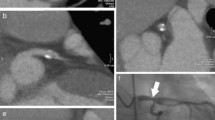Abstract
Selective coronary angiography is the current standard method for evaluating coronary atherosclerosis but is limited to symptomatic patients. Because direct, non-invasive visualization of coronary atherosclerosis would facilitate the detection of coronary artery disease (CAD) and the identification of high-risk subgroups among symptomatic or asymptomatic patients, electron-beam computed tomography (EBCT) has received considerable attention. The current article reviews the underlying principles of EBCT scanning of the coronary arteries, a number of experimental and clinical studies pertaining to the detection of CAD, and current and potential future applications.
EBCT permits high-resolution imaging of the beating heart and the coronary arteries. After intravenous contrast injections, it can be used to produce a coronary angiogram which has been shown to reliably rule out obstructive CAD in patients. But, the relatively high percentage of coronary arteries with inadequate image quality for analysis remains problematic. The visualization of coronary calcification by EBCT is routinely done in a number of laboratories. For clinical purposes, coronary calcification represents the formation of atherosclerotic plaques. EBCT provides for accurate quantification of calcification, which is itself related to the extent of coronary atherosclerosis in a linear fashion. Accordingly, EBCT has been shown to measure the extent of coronary atherosclerosis. By analyzing the amount of coronary calcification, the presence and likely severity of coronary obstructive stenoses can be estimated. However, determining the localization of stenoses remains elusive. Importantly, an EBCT scan negative for calcification has a high negative predictive value indicating the absence of obstructive CAD and an excellent short- to mid-term prognosis. It appears than in general, the amounts of calcification detected by EBCT can be used for prospective risk stratification in symptomatic and asymptomatic adults. For example, in one study extensive calcification identified asymptomatic individuals with a chance of sustaining a coronary event as high as 30% over 3.6 years. However, data derived from unbiases populations are not available at present, and the role of calcification in predicting acute coronary syndromes remains debated. The reproducibility of EBCT scanning for coronary calcification can be improved by using the volume or the – two-dimensional – area of calcified plaques rather than more complex systems. It appears then feasible to detect even small differences in the rate of progression of calcified plaque disease. Accordingly, longitudinal EBCT examinations have emerged as another area of substantial clinical interest. Measuring the progression of CAD may provide further prognostic information in addition to cross-sectional studies of its extent, and it may yield an important surrogate endpoint with regard to determining treatment effects.
Similar content being viewed by others
Author information
Authors and Affiliations
Additional information
Received: 16 June 1999, Returned for revision: 12 July 1999, Revision received: 19 July 1999, Accepted: 20 July 1999
Rights and permissions
About this article
Cite this article
Schmermund, A., Baumgart, D. & Erbel, R. Potential and pitfalls of electron-beam computed tomography in detecting coronary atherosclerosis. Basic Res Cardiol 94, 427–444 (1999). https://doi.org/10.1007/s003950050159
Issue Date:
DOI: https://doi.org/10.1007/s003950050159




